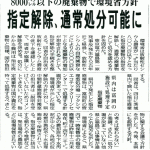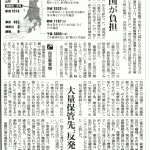Original Japanese written by staffer
The English below translated from the original Japanese by Heeday
The English translation edited by Rev. Dr. Henry French, ELCA
(Based on an article from the February 5th, 2016 editions of the Asahi Shimbun and Fukushima Minpo newspapers)
(▼Click each image and read the summary.)
As of the end of 2015, some 170,000 t (374,782,000 lb.) of “specified” waste is being stored, distributed in 12 prefectures. Six of them, Miyagi, Fukushima, Ibaraki, Tochigi, Gunma, and Chiba, have especially large volumes of such waste. The Ministry originally meant to gather the waste at a single disposal location in each of those prefectures. Fukushima decided to collect the waste into a privately-owned disposal site for industrial waste. In the other five prefectures, the relevant authorities, who tried to build new disposal sites, met with protests from residents around the candidate sites. Meanwhile, now almost five years after the 2011 disaster, some radioactive substances have naturally decayed and some waste has gone below the 8,000 becquerel threshold.
According to the Ministry’s new regulation regarding lifting the specification, first it must be confirmed that the particular waste has gone below the threshold. Then, the Ministry consults with the relevant municipal government over whether or not to lift the specification. Once the specification is lifted, if the municipality treats and disposes of the waste, the expense is to be covered by the national government.
In Ibaraki, the prefectural government said it was planning to enhance leakage prevention measures at current storage sites for such waste and then keep the waste there for years to come. The prefecture once tried to build a new, single, large disposal site inside the prefecture, but faced protests from residents living around the proposed site. In response, the Ministry asked the mayors of the relevant municipalities what they wanted to do with such proposed disposal sites, and the majority of them said that they wanted to keep the waste in current storage locations.
There are now only ten such disposal sites in Ibaraki, all of them on the premises of public facilities, such as water treatment plants. For prefectural governments, storage of waste within such premises is easy to take care of. Governor Hashimoto of Ibaraki said, “This was the only feasible choice, as we wanted to take measures as soon as possible to safely store such waste.” However, some estimate that 25 years from now, still up to 0.6 t (1,322 lb.) of radioactive waste will remain above the 8,000 becquerel threshold.
Meanwhile, Tochigi (some 70 miles north of central Tokyo) has much more specified waste kept in many more storage sites. Its governor, Tomikazu Fukuda, expressed his concerns over the Ministry’s new policy. Most of the specified waste within his prefecture consists of straw and is temporarily stored at farming houses. Over the last several years, the prefecture has experienced many tornados. In addition, in September 2015, a downpour hit Tochigi, as well as some other areas of southern Tohoku and Kanto. Under such weather conditions, the specified waste can disperse and/or run out of its temporary storage. The prefecture’s Governor Fukuda believes the specified waste should be gathered into a single storage, as soon as possible.
Though the Ministry’s intention in this policy change was to facilitate the reduction of specified waste, there is no guarantee that the treatment and disposal of “formerly specified” waste will work without any obstacles. True, the waste is not “specified” any longer, but it still contains radioactive substances. Therefore, many municipalities could face protests from residents around a candidate disposal site for “formerly specified” waste. And such residents’ fear is not groundless. In the near future, some containers of this waste could be damaged which would create serious treatment problems. Also, in the long run, those prefectures will have more uninhabited houses, which will add more combustible waste with radioactivity.
The Ministry of the Environment is planning to win consent to this new policy, saying that “we have scientific and technical knowledge that waste below 8,000 becquerel can be safely treated together with common (non-radioactive) waste.”
* Specified waste:
If any waste contaminated with radioactive substances from a nuclear power plant disaster is found to contain more than 8,000 becquerel of radioactive cesium, the relevant municipal authority reports it to the nation’s Minister of the Environment, who specifies the waste as “specified waste.” The cesium concentration in such waste decreases year by year, since Cs 134 has a half-life of 2 years and Cs 137 30 years.


